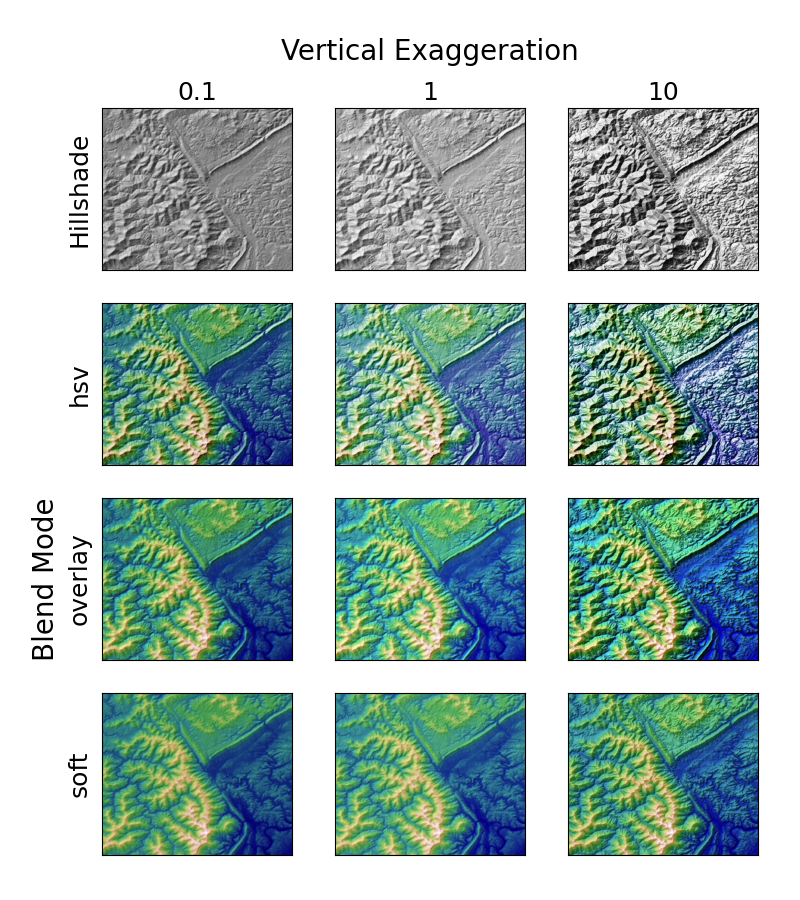地形山体阴影
在“山体阴影”图上展示不同混合模式和垂直夸大的视觉效果。
请注意,“叠加”和“柔和”混合模式适用于复杂曲面,例如此示例,而默认的“hsv”混合模式最适用于光滑曲面,例如许多数学函数。
在大多数情况下,山体阴影纯粹用于视觉目的,可以安全地忽略dx / dy。 在这种情况下,您可以通过反复试验调整vert_exag(垂直夸大)以获得所需的视觉效果。 但是,此示例演示了如何使用dx和dy kwargs来确保vert_exag参数是真正的垂直夸大。

import numpy as npimport matplotlib.pyplot as pltfrom matplotlib.cbook import get_sample_datafrom matplotlib.colors import LightSourcewith np.load(get_sample_data('jacksboro_fault_dem.npz')) as dem:z = dem['elevation']#-- Optional dx and dy for accurate vertical exaggeration ----------------# If you need topographically accurate vertical exaggeration, or you don't# want to guess at what *vert_exag* should be, you'll need to specify the# cellsize of the grid (i.e. the *dx* and *dy* parameters). Otherwise, any# *vert_exag* value you specify will be relative to the grid spacing of# your input data (in other words, *dx* and *dy* default to 1.0, and# *vert_exag* is calculated relative to those parameters). Similarly, *dx*# and *dy* are assumed to be in the same units as your input z-values.# Therefore, we'll need to convert the given dx and dy from decimal degrees# to meters.dx, dy = dem['dx'], dem['dy']dy = 111200 * dydx = 111200 * dx * np.cos(np.radians(dem['ymin']))#-------------------------------------------------------------------------# Shade from the northwest, with the sun 45 degrees from horizontalls = LightSource(azdeg=315, altdeg=45)cmap = plt.cm.gist_earthfig, axes = plt.subplots(nrows=4, ncols=3, figsize=(8, 9))plt.setp(axes.flat, xticks=[], yticks=[])# Vary vertical exaggeration and blend mode and plot all combinationsfor col, ve in zip(axes.T, [0.1, 1, 10]):# Show the hillshade intensity image in the first rowcol[0].imshow(ls.hillshade(z, vert_exag=ve, dx=dx, dy=dy), cmap='gray')# Place hillshaded plots with different blend modes in the rest of the rowsfor ax, mode in zip(col[1:], ['hsv', 'overlay', 'soft']):rgb = ls.shade(z, cmap=cmap, blend_mode=mode,vert_exag=ve, dx=dx, dy=dy)ax.imshow(rgb)# Label rows and columnsfor ax, ve in zip(axes[0], [0.1, 1, 10]):ax.set_title('{0}'.format(ve), size=18)for ax, mode in zip(axes[:, 0], ['Hillshade', 'hsv', 'overlay', 'soft']):ax.set_ylabel(mode, size=18)# Group labels...axes[0, 1].annotate('Vertical Exaggeration', (0.5, 1), xytext=(0, 30),textcoords='offset points', xycoords='axes fraction',ha='center', va='bottom', size=20)axes[2, 0].annotate('Blend Mode', (0, 0.5), xytext=(-30, 0),textcoords='offset points', xycoords='axes fraction',ha='right', va='center', size=20, rotation=90)fig.subplots_adjust(bottom=0.05, right=0.95)plt.show()

